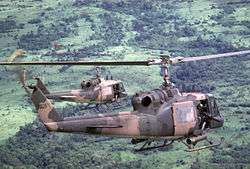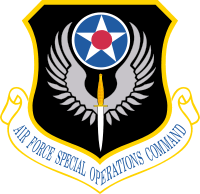20th Special Operations Squadron
| 20th Special Operations Squadron | |
|---|---|
|
20th Special Operations Squadron Patch | |
| Active |
2 March 1942 – 27 November 1945 9 July 1956 – 8 March 1960 24 September 1965 – 1 April 1972 1 January 1976 – present |
| Country | United States |
| Branch | United States Air Force |
| Type | Special Operations |
| Part of |
Air Force Special Operations Command 27th Special Operations Wing 27th Special Operations Group |
| Garrison/HQ | Cannon AFB |
| Nickname(s) | Pony Express/Green Hornets |
| Decorations |
|
The 20th Special Operations Squadron (20th SOS) is part of the 27th Special Operations Wing at Cannon AFB, New Mexico. It operates Bell Boeing CV-22 Osprey aircraft in support of special operations.
Mission
Conduct day or night low-level penetration into hostile enemy territory, to accomplish clandestine infiltration and exfiltration, aerial gunnery support and resupply of special operations forces throughout the world.[1]
History
The 20th Special Operations Squadron trained for aerial reconnaissance from, March 1942–December 1943, then went on to fly combat missions in the China-Burma-India Theater from, 31 January 1944 – 5 May 1945.[2]

The squadron was reactivated as the 20th Helicopter Squadron (HS) in 1956 to perform traditional helicopter missions with H-21s for the Tactical Air Command.
Vietnam War
In 1965, the unit's CH-3C helicopters were transferred to Southeast Asia and the squadron began participating in unconventional warfare and special operations in Laos and North Vietnam as the Pony Express.
In 1967, the 20th was joined by the UH-1F/P helicopters formerly assigned to Project Lucky Tiger and the Hueys became known as the Green Hornets. The "Green Hornets" supported Special Operations in South Vietnam and Cambodia. In August 1969 the Pony Express CH-3E's were transferred to the 21st Special Operations Squadron at Nakhon Phanom Royal Thai Air Force Base and the Pony Express ceased to exist. The heritage of the 20th was carried on by the 20th UH-1's Green Hornets.
- Aircraft and crew losses
- 31 March 1967, MAJ Robert L Baldwin, piloting UH-1F Tail No 65-07932 was shot and killed in Laos.[3]
- 26 November 1968, CAPT James P. Fleming earned the Medal of Honor for the rescue of 7 man Special Forces team near Đức Cơ, South Vietnam.[1]
- 27 November 1968, UH-1F Tail No 65-07942 operating from Ban Me Thuot East Airfield was shot down near Phu Nhai Village, Rotanokiri Province, Cambodia, 16 km west of Duc Lo, South Vietnam while trying to infiltrate a Special Forces team. The Crew Chief, SSgt Gene P. Stuifbergen[4] and 4 of the Special Forces team were trapped in the burning wreckage and were all listed as KIA-BNR.
- 3 January 1969, UH-1F Tail No 63-13164 operating from Ban Me Thuot was making its second attempt to extract a Special Forces patrol in Cambodia. As they came to a hover above the trees enemy fire struck the fuel cells setting the aircraft on fire. They were able to accelerate the aircraft and attempted a landing in a small jungle clearing but the engine failed just short of the clearing and the helicopter crashed into the trees. The crew chief, Sgt Ronald Zenga, was pinned under the aircraft and died in the ensuing fire.[5]
- 17 January 1969, Pony Express 20 CH-3C Tail No 62-12582 operating from Udorn Royal Thai Air Force Base crashed while on a TACAN service mission to Lima Site 36 in Laos. 3 of the crew were killed.[6][7][8]
- 26 March 1969, UH-1F Tail No 63-13158 operating from Ban Me Thuot crashed and burned near Dục Mỹ, north of Nha Trang, South Vietnam. The aircraft experienced severe vibration and auto-rotation was initiated but during the descent the main rotor severed the tail boom. All 5 crewmen were killed.[9][10][11][12][13]
- 13 April 1969, Capt James O. Lynch, piloting UH-1F, AF Ser. No. 65-07937, operating from Ban Me Thuot was shot and killed while extracting a reconnaissance team near Pleiku, South Vietnam.[14]
- 14 March 1970, UH-1P, AF Ser. No. 64-15491, operating from Ban Me Thuot was shot down while supporting a LRRP mission near Duc Lap, South Vietnam. The pilot, Capt Dana A. Dilley, was killed in the crash.[15] R.A. the Rugged Man tells the story of his father's (Sgt John A. Thorburn) part in this crash in the song Uncommon Valor: A Vietnam Story.
- 19 March 1970, UH-1P, AF Ser. No. 65-07944, operating from Ban Me Thuot was shot down near Darlac, South Vietnam. The Pilot, Copilot and a Gunner were killed in the crash.[16][17][18]
- 25 September 1970, UH-1P, AF Ser. No. 64-15484, operating from Ban Me Thuot hit trees while turning to avoid a mid-air collision with a VNAF CH-34 near Quang Duc, South Vietnam. The aircraft subsequently caught fire and the Pilot and a Gunner were killed in the crash.[19][20]
- 4 December 1971, a UH-1N operating from Ban Me Thuot came under fire near Saigon. The gunner, Sgt Thomas E. Fike, was killed.[21]
The Green Hornets continued to perform unconventional warfare missions for seven years, until inactivation in 1972.
-

SOS Huey in Laos
-

SOS UH-1Ps over Cambodia
-

UH-1P formerly operated by the 20th SOS on display at the National Museum of the United States Air Force
-

UH-1P Tail No 64-15493, probably used by 20th SOS, at Hurlburt Field
1976 Reactivation
Upon reactivation in 1976 at Hurlburt Field, the unit mission remained unconventional warfare and special operations using UH-1N gunships and CH-3Es. The HH-53H Pave Low replaced the CH-3E in 1980, providing a long range, heavier lift helicopter capability. "The Air Force's newly operational fleet of nine HH-53H Pave Low CSAR helicopters was abruptly transferred to the special operations forces in response to the failed Iranian hostage rescue attempt and the lack of dedicated long-range vertical lift platforms."[22][23]The crews used the Pave Low avionics to arrive over target on time and undetected, where they performed terminal operations wearing night vision goggles.[1]
In 1983, the UH-1Ns began two years of support as part of then Vice President George Bush's South Florida Drug Enforcement Task Force, participating in Operation Bahamas, Antilles and Turks (BAT). The Op BAT Hueys flew hundreds of over-water missions from the Bahamas before transferring to Homestead Air Force Base, Florida in 1985.[1]
In 1986, the 20th flew the specially equipped and highly capable MH-53H Pave Low and started flying the upgraded MH-53J Pave Low III in 1988.[1]
In December 1989, members of the 20 SOS were mobilized as part of a joint task force for Operation Just Cause, in Panama.[1]
The 20th was among the first units to deploy to Operation Desert Shield in August 1990, squadron crew members and aircraft led U.S. Army AH-64 Apaches in the air strike, opening the air war in Operation Desert Storm. A 20 SOS crew rescued U.S. Navy Lieutenant Devon Jones, logging the first successful combat rescue of a downed Airman since the Vietnam War. The crew earned the MacKay Trophy for their accomplishments.[1]
Squadron personnel deployed in support of Operation Restore Democracy in Haiti, providing support to a National Command Authority resolution. Members of the 20th, participating in operations in Bosnia and Herzegovina, went into harms way in attempting a rescue of two downed French crewmen, receiving two Purple Heart Medals and the Cheney Award.[1]

20 SOS crews were also involved in the search and rescue operations resulting from the CT-43 crash in which Commerce Secretary Ron Brown and his party lost their lives. These same crews deployed shortly thereafter to support the American Embassy evacuations in Monrovia, Liberia – airlifting more than 2,000 evacuees to safety. The squadron deployed crews and aircraft to Southwest Asia in support of United States Central Command and Operation Desert Thunder in February 1998. The Pave Low gave the theater commander a night, all-weather personnel recovery capability, unparalleled in the U.S. inventory.[1]
In 1999, the Pave Low III's were upgraded to the MH-53M Pave Low IV. The M model brought more technology and superior avionics to the mission, furthering the capabilities and resources available to the crews flying the helicopter. These new technologies were battle tested during Operation Allied Force when the 20 SOS rescued downed pilots from an F-117 and an F-16, earning two Silver Stars and numerous Distinguished Flying Crosses.[1]
In 2001, the 20th was quick to respond in the initial recovery efforts at The Pentagon and Ground Zero in New York City supporting Operation Noble Eagle. Additionally, the 20th rapidly deployed in support of Operation Enduring Freedom, engaging in the fight against terrorism in Afghanistan with continuing endeavors into Iraq as the Global War on Terror continues.[1]
To date, the Green Hornets have flown direct assaults on numerous high-profile targets and effected the rescue and exfiltration of hundreds of US and allied soldiers. Included among these actions are the daylight medevac of 32 injured soldiers in the midst of a battle and the rescue of a downed aircrew deep in hostile territory, which earned the squadron its second MacKay Trophy.[1]
Operations
|
Source:[1]
Lineage
- 20th Observation Squadron (Light) (1942)
- 20th Observation Squadron (1942–1943)
- 20th Reconnaissance Squadron (Fighter) (1943)
- 20th Tactical Reconnaissance Squadron (1943–1956)
- 20th Helicopter Squadron (1956–1968)
- 20th Special Operations Squadron (1968 – present)
Source:[2]
Assignments
- 76th Reconnaissance Group (1942–1943)
- III Reconnaissance Command (1943)
- 5306th Photographic and Reconnaissance Group (Provisional) (1943–1944)
- 8th Reconnaissance Group (1944–1945)
- Eighteenth Air Force (1956–1957)
- Ninth Air Force (1957–1960)
- Attached: 314th Troop Carrier Wing (1956–1959)
- Attached: 354th Tactical Fighter Wing (1959–1960)
- 2d Air Division (1965–1966)
- Attached: 6250th Combat Support Group (10 December 1965 – 8 March 1966)
- 14th Special Operations Wing (1966–1971)
- 483d Tactical Airlift Wing (1971–1972)
- 1st Special Operations Wing (1976–2008)
- 27th Special Operations Group (2010–present)
- 27th Special Operations Wing (2010–present)
Source:[2]
Bases stationed
|
|
Aircraft operated
|
|
References
Notes
- 1 2 3 4 5 6 7 8 9 10 11 12 13 20 SOS Fact Sheet
- 1 2 3 4 AFHRA 20 SOS Page
- ↑ "MAJ Robert L Baldwin". The Virtual Wall.
- ↑ "SSGT Gene P Stuifbergen". The Virtual Wall.
- ↑ "SGT Ronald P Zenga". The Virtual Wall.
- ↑ "MAJ Walter W Martin". The Virtual Wall.
- ↑ "CAPT Richard A Fleming". The Virtual Wall.
- ↑ "SSGT Albert J Davis". The Virtual Wall.
- ↑ "LTC Frank A DiFiglia". The Virtual Wall.
- ↑ "CAPT Walter C Booth". The Virtual Wall.
- ↑ "CAPT Robert W Fields". The Virtual Wall.
- ↑ "TSGT Jesse C Bowman". The Virtual Wall.
- ↑ "SGT Antonio L Alho". The Virtual Wall.
- ↑ "CAPT James O Lynch". The Virtual Wall.
- ↑ "CAPT Dana O Dilley". The Virtual Wall.
- ↑ "MAJ Clyde W Enderle". The Virtual Wall.
- ↑ "CAPT Carlos A Estrada". The Virtual Wall.
- ↑ "TSGT James W Greenwood". The Virtual Wall.
- ↑ "CAPT Jackie P Heil". The Virtual Wall.
- ↑ "MSGT Gerald A Cooper". The Virtual Wall.
- ↑ "SGT Thomas E Fike". The Virtual Wall.
- ↑ http://www.hurlburt.af.mil/AboutUs/FactSheets/FactSheets/tabid/140/Article/204557/mh-53-pave-low.aspx
- ↑ Fort Walton Beach, Florida, "Today in Local History", Northwest Florida Daily News, Thursday 18 June 2015, Volume 69, Number 137, page A5.

